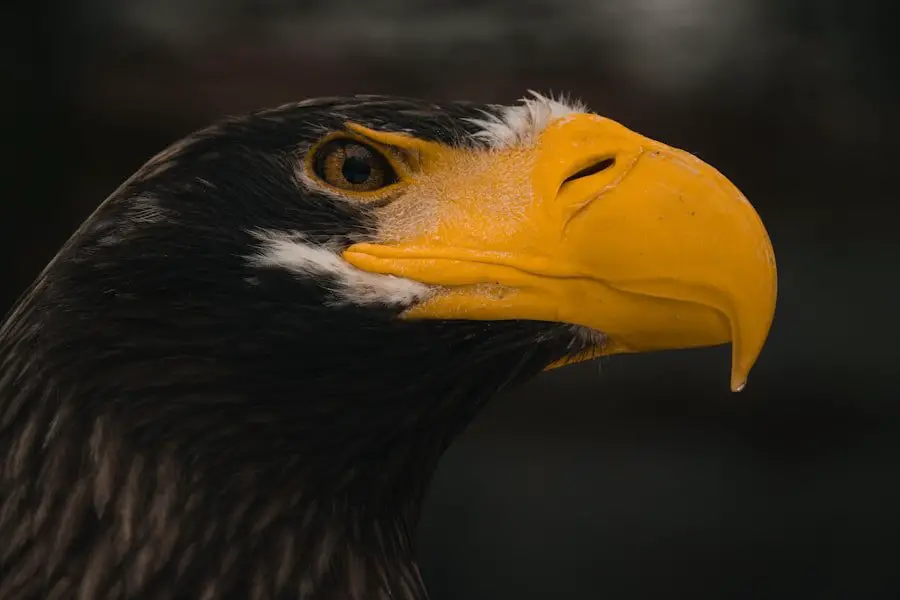Bird raptors, or birds of prey, are a diverse group of avian predators characterized by their sharp talons, powerful beaks, and exceptional eyesight. These birds are found on all continents except Antarctica, inhabiting various ecosystems from deserts to forests and urban areas. Raptors play a crucial ecological role by regulating prey populations and maintaining ecosystem balance.
Raptors are classified into two main categories: diurnal and nocturnal. Diurnal raptors, active during daylight hours, include eagles, hawks, falcons, and vultures. Nocturnal raptors, primarily owls, are adapted for hunting in low-light conditions.
Each group has evolved specific hunting strategies and physical adaptations suited to their preferred prey and habitat. Throughout history, bird raptors have held significant cultural importance, often symbolizing power and strength in mythology and folklore. Their impressive aerial abilities and hunting skills continue to fascinate researchers, birdwatchers, and wildlife enthusiasts.
Today, raptor conservation efforts are crucial for preserving biodiversity and maintaining healthy ecosystems worldwide.
Key Takeaways
- Bird raptors are predatory birds known for their keen eyesight, powerful talons, and hooked beaks.
- They have excellent adaptations for hunting, including sharp beaks for tearing flesh and strong, grasping talons for catching prey.
- There are different types of bird raptors, including eagles, hawks, falcons, and owls, each with unique characteristics and hunting styles.
- Bird raptors play a crucial role in ecosystems by controlling prey populations and maintaining a balance in the food chain.
- Conservation efforts for bird raptors are important to protect these birds from habitat loss, illegal hunting, and other threats, and to ensure their continued presence in the wild.
Characteristics and Adaptations of Bird Raptors
Bird raptors possess a number of unique characteristics and adaptations that make them well-suited for their predatory lifestyle. One of the most notable features of bird raptors is their keen eyesight, which allows them to spot prey from great distances. Their eyes are equipped with a high density of light-sensitive cells called cones, which enable them to see with exceptional clarity and detail.
In addition to their sharp vision, bird raptors also have excellent hearing, which helps them locate prey that may be hidden from view. Their ability to pinpoint the location of their prey using both sight and sound makes them highly effective hunters. Another key adaptation of bird raptors is their powerful beaks and talons, which they use to capture and kill their prey.
Their beaks are hooked and sharp, allowing them to tear into the flesh of their prey with ease. Their talons are also strong and curved, enabling them to grasp onto their prey tightly and prevent it from escaping. Additionally, bird raptors have strong, muscular legs that enable them to carry their prey back to their nests or feeding sites.
These adaptations make them formidable predators and allow them to thrive in a wide range of environments.
Different Types of Bird Raptors

There are several different types of bird raptors, each with its own unique characteristics and hunting strategies. One of the most well-known types of bird raptors is the eagle, which is known for its impressive size and strength. Eagles are powerful fliers and are capable of carrying prey that is nearly equal to their own body weight.
They are often found near bodies of water where they can hunt for fish, but they are also known to prey on small mammals and other birds. Hawks are another type of bird raptor that are known for their agility and speed. They are often seen soaring high in the sky as they search for prey, using their keen eyesight to spot potential targets.
Once they have located their prey, hawks will dive down at incredible speeds to capture it with their sharp talons. Falcons are similar to hawks in many ways but are known for their exceptional speed and aerial acrobatics. They are capable of reaching speeds of over 200 miles per hour when diving to catch their prey.
Vultures are a unique type of bird raptor that are scavengers, feeding on the carcasses of dead animals. They play an important role in cleaning up the environment by consuming carrion that would otherwise attract disease and pests. Owls are nocturnal bird raptors that are known for their silent flight and exceptional hearing.
They have specialized feathers that allow them to fly silently through the night as they hunt for small mammals and insects.
Hunting and Feeding Habits of Bird Raptors
| Raptor Species | Hunting Technique | Prey |
|---|---|---|
| Red-tailed Hawk | Still-hunting | Small mammals, birds |
| Peregrine Falcon | Diving | Other birds |
| Osprey | Plunging | Fish |
| Golden Eagle | Stoop-hunting | Large mammals |
Bird raptors have a diverse range of hunting and feeding habits that reflect their unique adaptations and ecological roles. Diurnal raptors such as eagles, hawks, and falcons are active during the day and rely on their keen eyesight to locate prey from great distances. Once they have spotted a potential target, they will use their powerful wings and sharp talons to swoop down and capture it.
Some diurnal raptors, like falcons, are known for their exceptional speed and agility, allowing them to catch fast-moving prey such as birds in mid-flight. Nocturnal raptors such as owls have adapted to hunt in low light conditions using their exceptional hearing and silent flight. They rely on their keen sense of hearing to locate small mammals and insects in the darkness, using their sharp talons to capture their prey with precision.
Vultures, on the other hand, are scavengers that feed on the carcasses of dead animals. They play an important role in cleaning up the environment by consuming carrion that would otherwise attract disease and pests. Once they have captured or located their prey, bird raptors will use their sharp beaks and talons to tear into the flesh and consume it.
They have strong digestive systems that allow them to process bones, feathers, and fur, which they will regurgitate as pellets after digestion. This efficient method of feeding allows them to extract as much nutrition as possible from their prey.
The Role of Bird Raptors in Ecosystems
Bird raptors play a crucial role in maintaining the balance of ecosystems by controlling the populations of their prey species. By preying on animals such as rodents, insects, and small mammals, bird raptors help to prevent overpopulation and maintain the health of plant communities. This in turn has a cascading effect on other species within the ecosystem, helping to regulate food webs and maintain biodiversity.
In addition to controlling prey populations, bird raptors also act as indicators of ecosystem health. Because they occupy the top of the food chain, they are particularly sensitive to changes in the environment such as pollution or habitat loss. Monitoring the populations of bird raptors can provide valuable insights into the overall health of an ecosystem and help guide conservation efforts.
Furthermore, bird raptors contribute to nutrient cycling within ecosystems through their feeding habits. By consuming carrion or regurgitating pellets containing indigestible parts of their prey, they help to recycle nutrients back into the environment. This process is essential for maintaining the fertility of soils and supporting the growth of plant communities.
Conservation Efforts for Bird Raptors

Despite their important ecological roles, many species of bird raptors are facing threats from human activities such as habitat destruction, pollution, and illegal hunting. Conservation efforts for bird raptors focus on protecting their habitats, reducing human-wildlife conflicts, and monitoring populations to ensure their long-term survival. One key conservation strategy is the establishment of protected areas such as national parks and wildlife reserves where bird raptors can thrive without disturbance.
These areas provide essential habitat for nesting, feeding, and migration, helping to safeguard populations from human encroachment. Another important aspect of conservation efforts for bird raptors is reducing human-wildlife conflicts. This can involve implementing measures to prevent accidental poisoning from pesticides or lead ammunition, which can have devastating effects on bird raptor populations.
Education and outreach programs can also help raise awareness about the importance of conserving bird raptors and promote coexistence between humans and wildlife. Monitoring populations through scientific research and citizen science initiatives is crucial for understanding the status of bird raptor species and identifying potential threats. By collecting data on population trends, breeding success, and habitat use, conservationists can develop targeted conservation strategies to address specific challenges facing different species.
Interactions between Bird Raptors and Humans
Throughout history, bird raptors have captured the imagination of humans and have been revered as symbols of power and strength in many cultures. They have been depicted in art, literature, and mythology as noble creatures with extraordinary abilities. In some cultures, certain species of bird raptors were even considered sacred or were associated with deities.
In modern times, bird raptors continue to captivate people’s interest through activities such as falconry, where trained birds of prey are used for hunting or sport. Falconry has a long history dating back thousands of years and is still practiced in some parts of the world today as a traditional art form. However, interactions between bird raptors and humans have not always been positive.
In some cases, bird raptors have been viewed as threats to livestock or game animals, leading to persecution by humans. This has resulted in declines in populations of certain species and has led to conflicts between conservationists and those who view bird raptors as pests. Despite these challenges, there is growing appreciation for the important role that bird raptors play in maintaining healthy ecosystems.
Efforts to conserve these magnificent birds continue to gain momentum as people recognize the value of preserving these apex predators for future generations to enjoy. In conclusion, bird raptors are a diverse group of birds with unique characteristics and adaptations that make them formidable predators. They play a crucial role in maintaining the balance of ecosystems by controlling prey populations and contributing to nutrient cycling.
Conservation efforts are essential for protecting these magnificent birds from threats such as habitat loss and human-wildlife conflicts. By working together to safeguard their habitats and raise awareness about the importance of conserving bird raptors, we can ensure that these majestic birds continue to soar through our skies for generations to come.
For more information on bird raptors, check out this article about the intense rivalry between the Kansas City Chiefs and the Miami Dolphins in the wild card playoff.
FAQs
What is a bird raptor?
A bird raptor, also known as a bird of prey, is a type of bird that hunts and feeds on other animals. They are characterized by their sharp talons, hooked beaks, and keen eyesight.
What are some examples of bird raptors?
Some examples of bird raptors include eagles, hawks, falcons, owls, and vultures.
What do bird raptors eat?
Bird raptors primarily feed on small mammals, birds, reptiles, and sometimes insects. Their diet varies depending on the species and their hunting habits.
How do bird raptors hunt?
Bird raptors use a variety of hunting techniques, including soaring and diving to catch their prey. They use their sharp talons to grasp and kill their prey, and their hooked beaks to tear the flesh.
Where can bird raptors be found?
Bird raptors can be found on every continent except Antarctica. They inhabit a wide range of habitats, including forests, grasslands, deserts, and mountains.
Are bird raptors endangered?
Some species of bird raptors are endangered due to habitat loss, pollution, and illegal hunting. Conservation efforts are in place to protect these species and their habitats.




















+ There are no comments
Add yours